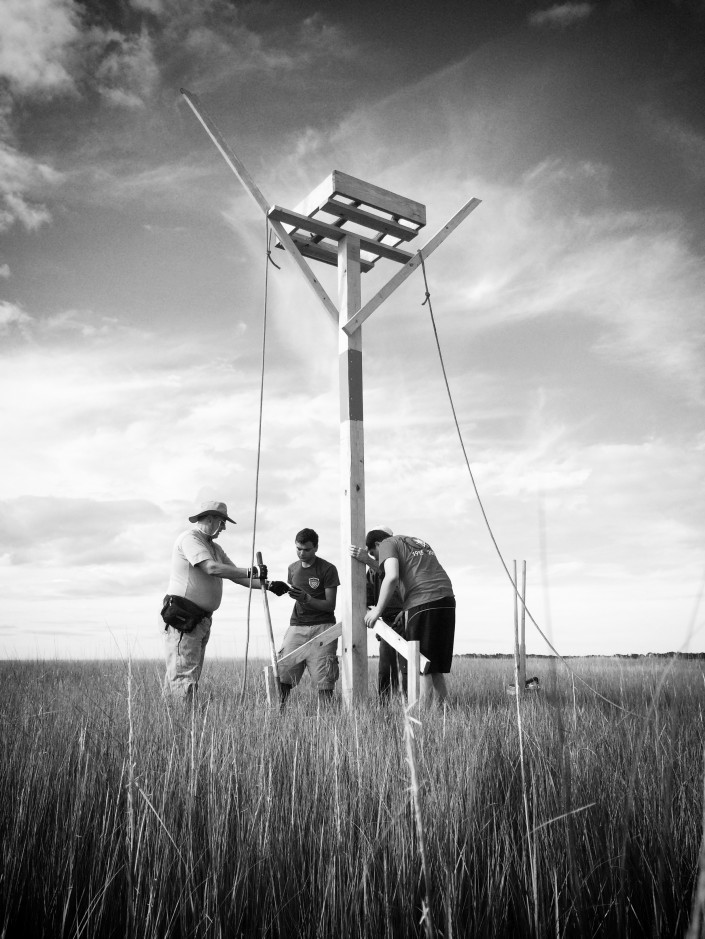Tag: Barnegat Bay
Project RedBand is a go!
Time to get outside and watch some ospreys!
by Ben Wurst, Habitat Program Manager
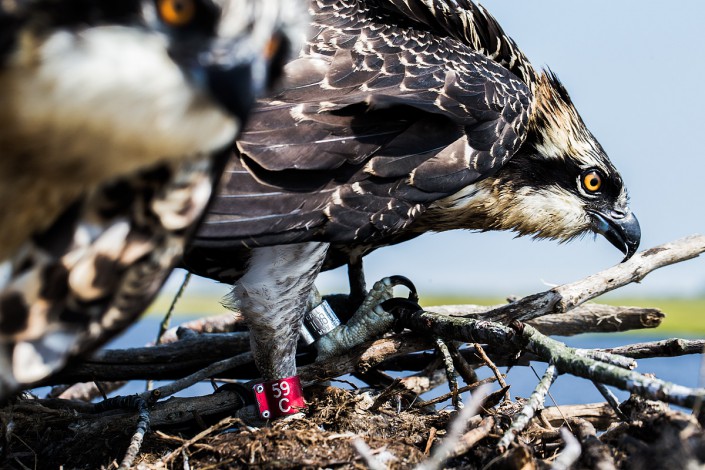
A lot has changed throughout the 40 project history of the New Jersey Osprey Project. From a low of only 53 osprey pairs (statewide) in 1973, today there are more than 540 pairs that return here each year to feed, nest, and raise young. In the beginning work to re-establish their population was a trementous undertaking. Ospreys, a were loaded with environmental contaminents (DDT, which caused the thinning of egg shells), their habitat was bulldozed, and early on birds were shot for their feathers and eggs. Once the Endangered Species Conservation Act of 1973 ospreys were afforded protection they deserved, and work by biologists like Pete McLain were underway to restore the population in New Jersey. Continue reading “Project RedBand is a go!”
Island Beach State Park: Meet the Programs!
When it comes to choosing which Island Beach State Park Programs are best for you, it’s tough to decide from so many great options!
So today we bring you the expert naturalists and educators who teach the programs. Hear their own evocative stories behind each program then decide what’s best for you!
Part 1, Monday, summarized these exciting programs. Part 2, Tuesday, highlighted the Harvest the Bay Day happening this Saturday, August 9 from 3-8pm. Part 4, Thursday, will be a round table interview with the Island beach State Park naturalists. And Part 5, Friday, will feature a personal account from one of CWF’s interns who works at Island Beach State Park.
John Leonard, Park Naturalist, Island Beach State Park
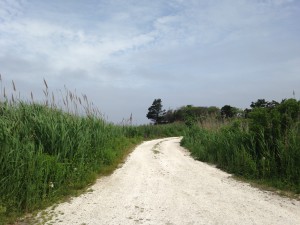 As a Park Naturalist for THE best park within the NJ Parks and Forestry system I’ve been able to do some wickedly fun and educational things within its borders for the past five years. From fishing its shores for monster striped bass, to kayaking and seining the waters of Barnegat Bay. Nothing satisfies me more than sharing those experiences and seeing the smiles with the thousands of visitors who visit our park daily. But what if I told you, the adventurous few, we have a program that happens only twice a summer, and is scheduled during a time and at a place where the park becomes virtually deserted. Alone. On a barrier island. Far from the lights and crowds you are accustomed to at the Jersey Shore. Tempted?
As a Park Naturalist for THE best park within the NJ Parks and Forestry system I’ve been able to do some wickedly fun and educational things within its borders for the past five years. From fishing its shores for monster striped bass, to kayaking and seining the waters of Barnegat Bay. Nothing satisfies me more than sharing those experiences and seeing the smiles with the thousands of visitors who visit our park daily. But what if I told you, the adventurous few, we have a program that happens only twice a summer, and is scheduled during a time and at a place where the park becomes virtually deserted. Alone. On a barrier island. Far from the lights and crowds you are accustomed to at the Jersey Shore. Tempted?
The Full Moon Hike begins deep in the park, 3.5 miles past our bathing beaches at our Nature Center, a building many say is haunted by old souls of the sea. After a quick introduction of your guides at dusk we begin our educational journey, slowly working our way westward through the dense maritime forest. Quietly walking all our senses slowly awaken. The sounds of far off birds, rustling of mammals and amphibians in the undergrowth searching for a meal, pungent odors of decaying matter all come into focus. Learning as we walk, taking note of all our surroundings. As we reach Barnegat Bay we are rewarded by a liquid orange sun dipping slowly beneath the horizon illuminating the sky in a spectrum of color, a perfect time to observe the bay and all its glory.
Retracing our steps with natural light fading we begin our trek ocean side. Dense, dark forest gives way to the moonscape like terrain of our secondary, then primary dune system. A place that seems inhabitable, but in fact are home to our famed red fox. In addition to being extremely important barriers of ocean storm surge, these dunes have been rumored to hold buried treasure from pirates as far back as the 1600’s.
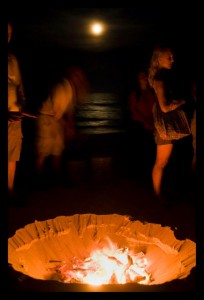 As we cross that final dune we leave the quiet solitude of the secondary dunes and are rewarded with an impressive elevated view of the ocean and sands which we’ve all come to love. Immediately we feel the air temperature drop, we hear thundering waves crashing on our pristine shores and view a brilliant burning fire just waiting for us to enjoy. Here we are free to enjoy the beach, collect shells or simply gather around the fire and enjoy the dancing flames as the yellow full moon slowly rises above the waves in the eastern sky. As an added bonus for all guests big and small, we are comforted by the melty goodness of roasting marshmallows, decedent chocolate and lightly sweet graham crackers to enjoy.
As we cross that final dune we leave the quiet solitude of the secondary dunes and are rewarded with an impressive elevated view of the ocean and sands which we’ve all come to love. Immediately we feel the air temperature drop, we hear thundering waves crashing on our pristine shores and view a brilliant burning fire just waiting for us to enjoy. Here we are free to enjoy the beach, collect shells or simply gather around the fire and enjoy the dancing flames as the yellow full moon slowly rises above the waves in the eastern sky. As an added bonus for all guests big and small, we are comforted by the melty goodness of roasting marshmallows, decedent chocolate and lightly sweet graham crackers to enjoy.
Please join us as we begin our journey.
“Seining tours are a fun, interactive way for kids and adults to gain first hand experience with the marine life in our area. They are also an invaluable tool for school groups learning about coastal ecology” – Becca Hanson, Seasonal Supervisor
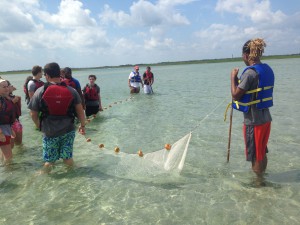 Did you know that IBSP offers free daily seining tours every day, twice a day? Pull a seine net through the Barnegat Bay and discover the amazing creatures who live here. Can you scare away hungry predators by growing twice your size in less than 6 seconds? A pufferfish can! Scoop up some silversides, the ‘french fries of the bay’, and understand the importance of this abundant fish in the Barnegat Bay food chain. Meet the snails, our bottom-feeding friends who keep the bay clean. What’s today’s catch of the day?
Did you know that IBSP offers free daily seining tours every day, twice a day? Pull a seine net through the Barnegat Bay and discover the amazing creatures who live here. Can you scare away hungry predators by growing twice your size in less than 6 seconds? A pufferfish can! Scoop up some silversides, the ‘french fries of the bay’, and understand the importance of this abundant fish in the Barnegat Bay food chain. Meet the snails, our bottom-feeding friends who keep the bay clean. What’s today’s catch of the day?
The Snorkel/Kayak Program at Island Beach State Park is a mix of snorkeling and kayaking in the Barnegat Bay. After a brief introduction and overview of the necessary kayaking skills, participants start the tandem kayaking adventure. All snorkel gear and kayak gear are provided. Park educators explain the ecology and importance of the Barnegat Bay and its ecosystems, and also review the different species that can be expected while snorkeling. When the tide is right, kayaks are anchored on a nearby sand bar and participants can snorkel in the adjacent deeper channel. Participants may see a variety of species, such as pipefish, crabs, flounder, hermit crabs, schools of bait fish, as well as different types of aquatic vegetation. This tour is new at the park and is becoming increasingly popular! Come join us for this unique underwater ecosystem viewing experience!
“From my personal experience with this program I find that it gives the children a wonderful hands-on approach to understanding the natural balance that takes place at Island Beach State Park.”- Josephine, Park Educator
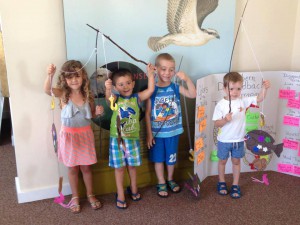
This program is specifically designed for children ages 3 to 5 years old and takes place at the Nature Center. Age-appropriate hands-on activities, stories, crafts and hikes guide your child’s natural curiosity as they explore the animals and plants of Island Beach State Park. Natural Educators provide an educational hour of fun for parents and their children.
“From an educators stand point, I find that this program truly enriches the child’s love of learning. This program is supported with appropriate children’s literature and affords the children the opportunity to learn hands on; which in my experience is the most beneficial. It is delightful to take part in helping to create memories that are sure to last for a life time!” – Lisa, Park Educator
This program is specifically designed for children ages 6 to 12 years old and takes place at the Nature Center. With the help of Natural Educators, children get the chance to explore the outdoors, make crafts, listen to stories, learn about animals, and investigate the local ecosystem. This is a two hour program that explores different topics each week such birds, turtles, jellyfish, and much more!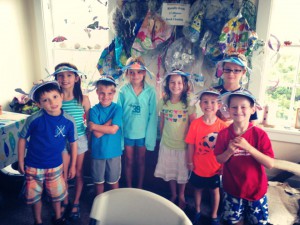
IBSP Kayak Tours
Most people come to Island Beach State park to enjoy the swimming beaches. They drive to Ocean Beach Area 1 or 2, spend a few hours on the beach and go home feeling satisfied with their visit to the park. Little do they know they have only scratched the surface in terms of what this park has to offer!
Kayak tours are one of the more popular activities provided by IBSP park educators. Below is a list of tours and a brief description of each:
Learn about the history of Island Beach dating back to the first recorded description in 1609 by Robert Juet, the first mate to Henry Hudson, the parks involvement in the Revolutionary war, the War of 1812, pirates in the park, all the way to present day uses. All of this is done while kayaking around the Island visiting important historical landmarks and enjoying the beautiful Island ecosystems.
“The sunset paddle is one of my favorite programs offered at the park. Being on the water, witnessing the natural serenity of the area and its inhabitants, and watching the brilliant colors of the sunset is an experience like no other.” – Kelly Scott, Park Naturalist
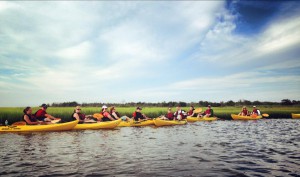 Enjoy a peaceful and relaxing evening paddle through the famous Sedge Islands and watch the sunset over Barnegat Bay. This is prime time for observing the parks different wildlife species, including egrets, herons, gulls, turtles and maybe even a lingering fox watching from shore.
Enjoy a peaceful and relaxing evening paddle through the famous Sedge Islands and watch the sunset over Barnegat Bay. This is prime time for observing the parks different wildlife species, including egrets, herons, gulls, turtles and maybe even a lingering fox watching from shore.
Learn about one of the largest estuaries in NJ by kayak! Park educators will discuss the bay’s geology, ecological function and importance, and local flora and fauna. In addition, the Eco-tour also includes a seining event to observe marine life and park educators will teach the “clammers dance.”
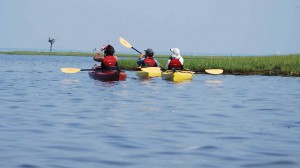 Expert Park Natural Educators will guide you on a peaceful paddle through the dynamic Barnegat Bay estuarine ecosystem. Discover the diversity of birds that inhabit Island Beach State Park in the summer. We will discuss migration patterns and year-round residents. Keep an eye out for additional birding tour during the upcoming fall migration!
Expert Park Natural Educators will guide you on a peaceful paddle through the dynamic Barnegat Bay estuarine ecosystem. Discover the diversity of birds that inhabit Island Beach State Park in the summer. We will discuss migration patterns and year-round residents. Keep an eye out for additional birding tour during the upcoming fall migration!
Nature Center/Interpretive Center
Do you want to see wildlife close-up – and spend a day at the beach? Then come visit the Island Beach State Park Nature Center!
Once a coast guard building, the Nature Center showcases a unique combination of amazing views and lots of interactive fun for the whole family. Our Nature Center is home to a wide variety of local creatures from our 2 year old albino corn snake Newton, to our baby diamondback terrapins. Dont forget to take in the spectacular view from the top floor where the bay, the ocean, and Barnegat Bay lighthouse are all visible.
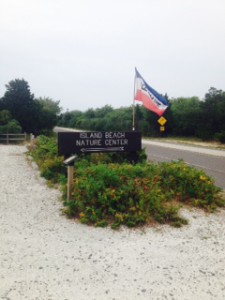 Just across from the Nature Center is the Forked River Interpretive Center where visitors can enter the world of yesterday and explore the incredible history of Island Beach State Park. Visitors can learn about the massive effort to bring Ospreys back to the Island, the historic Reeds Hotel and many other amazing stories and tales of life as it used to be on this breathtaking island.
Just across from the Nature Center is the Forked River Interpretive Center where visitors can enter the world of yesterday and explore the incredible history of Island Beach State Park. Visitors can learn about the massive effort to bring Ospreys back to the Island, the historic Reeds Hotel and many other amazing stories and tales of life as it used to be on this breathtaking island.
Before you leave, make sure you take a visitors guide and check out the Summer Programs offered by IBSP Park Naturalists and educators! Let us show you how much fun nature can be!
“Surfing Safari is by far the most popular WILDCHILD program offered at IBSP. Space is limited, and classes typically fill up fast. Register early to reserve your spot!” – Tom Seager, Park Educator
Surf’s Up Dude!
Learn about waves, what they are, where they come from, and why they break. Paddle out with expert Natural Educators and IBSP Lifeguards, and maybe you’ll be hangin’ 10 by the end of the summer! Drop off your child for two hours of fun!
Harvest the Bay Day!
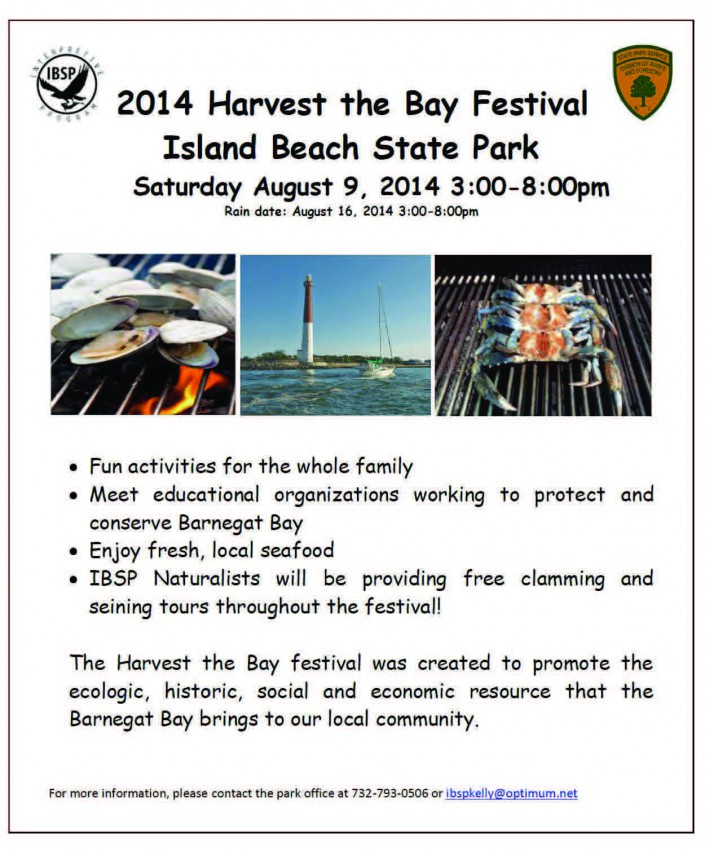 Part 1, Monday, was an introduction to these exciting programs. Part 3, Wednesday, gave the “Insider’s Look” into the amazing outdoor programs, told through the words of the experts teaching the programs at Island Beach State Park. Part 4, Thursday, was a roundtable interview with the Island Beach State Park naturalists. And Part 5, Friday, will feature a personal account from one of CWF’s interns who works at Island Beach State Park.
Part 1, Monday, was an introduction to these exciting programs. Part 3, Wednesday, gave the “Insider’s Look” into the amazing outdoor programs, told through the words of the experts teaching the programs at Island Beach State Park. Part 4, Thursday, was a roundtable interview with the Island Beach State Park naturalists. And Part 5, Friday, will feature a personal account from one of CWF’s interns who works at Island Beach State Park.
The rich ecological resources of Barnegat Bay and IBSP, coupled with high numbers of visiting park patrons serves as the perfect backdrop for our Harvest the Bay Festival. IBSP, has two extensive natural areas, coupled with two large points of recreational usage and a marine conservation zone, making it an easy link to demonstrate the function of healthy coastal ecosystem, the effects of human interaction and beneficial aspects of management. Each year, the park hosts over 1 million guests that that engage in boating, clamming, fishing, swimming, and hiking along the 10 miles of shoreline.
Barnegat Bay acts as an early life history nursery for many species of fish/invertebrates that are both recreationally and commercially significant in terms of harvest. The bay supports healthy aquatic flora including submerged aquatic vegetation and phytoplanktonic growth. Subsequently, early life history stages of coastal bivalves, crustaceans and forage fish occur along the bay because of high levels of primary productivity. However, some fisheries resources in Barnegat Bay have experienced a decline in recent years. Despite healthy levels of biological productivity in Barnegat Bay, anthropogenic effects do require monitoring and education to better promote coastal stewardship including coastal development along the watershed, increased nutrient loading, decreases in dissolved oxygen/pH, habitat loss, and the effects of over-harvesting marine resources.
The Harvest the Bay Festival was designed to promote the value of shellfish and finfish as food resources in Barnegat Bay by highlighting their ecological, economic and social importance. Vendors from governmental, non-profit and private organizations will be present to discuss with the public, the importance of Barnegat Bay to their mission. Also, local restaurant vendors will be present to display locally caught food selections of Barnegat Bay and the adjacent coastal ocean. Ultimately, the goal of the Harvest the Bay Day is to celebrate the importance of Barnegat Bay and educate the public about its significance, while promoting the following Harvest the Bay educational programs:
Harvest the Bay Clamming
Harvest the Bay-Clamming is one of the best ways to experience Barnegat Bay. Join park educators and learn about the anatomy of Quahog clams, their ecological importance in the bay, harvesting restrictions, and more. The program provides clam rakes or you can use your feet! Learn the skills and “clam-dance” of the baymen that still live in the area. While clamming, you are also likely to encounter some of the birds of Island Beach State Park such as the Osprey and Oyster Catcher.
Harvest the Bay Crabbing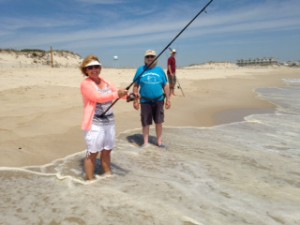
Discover the fascinating life cycle of the Blue Claw Crab, its niche in the ecosystem, when and how to harvest them, and what you can do to assure their populations remain at a healthy level.
Harvest the Bay Fishing
Bluefish, Fluke, Black Drum – the bay is host to a variety of local fish. Explore the role of finfish in the bay’s ecosystem and discover techniques for successful fishing. Cast a line into the bay and reel in your catch of the day!
Highlighting the Island Beach State Park Programs!
The Jersey Shore has changed immeasurably over the past century. But one place gives you the chance to recapture the beauty and wild feeling that once encompassed the entire coast – Island Beach State Park.
At Island Beach State Park, you can still find hands-on adventures along the Atlantic Coast and the Barnegat Bay. You can still be immersed in the nature of coastal beach dunes, maritime forest, and vast saltmarsh. You can still find wildlife like osprey, red fox, diamondback terrapins, piping plover, sea turtles, and an incredible array of fish and shellfish.
This week CWF is highlighting the hands-on interactive learning programs offered at Island Beach State Park. This marks the first of five blog stories that will spotlight these programs.
Part 1, Today, will be an introduction to these exciting programs. Part 2, Tuesday, will highlight the Harvest the Bay Day happening this Saturday, August 9 from 3-8pm. Part 3, Wednesday, will give the “Insider’s Look” into the amazing outdoor programs, told through the words of the experts teaching the programs at Island Beach State Park. Part 4, Thursday, will be a roundtable interview with the Island Beach State Park naturalists. And Part 5, Friday, will feature a personal account from one of CWF’s interns who works at Island Beach State Park.
 CWF is excited to partner with New Jersey State Parks and offer incredible programs about New Jersey’s natural world at Island Beach State Park.
CWF is excited to partner with New Jersey State Parks and offer incredible programs about New Jersey’s natural world at Island Beach State Park.
Become a WILDCHILD, take a sunset kayak tour, try your hand at surf-fishing, go bird watching, or enjoy a movie night at the park! Whatever you decide, you will be guided by professional educators and naturalists who have plenty of natural and wildlife stories to share with you.
At nearly 10 miles long, Island Beach is New Jersey’s most expansive stretch of undeveloped barrier island. Our programs help you to connect with the beauty of this ecosystem and its ample natural resources. Have your kids participate in a WILDCHILD program including surfing, surf-fishing, and island exploration. Try and catch the big one during a surf-fishing class or discover the beauty of Barnegat Bay through kayaking.
Osprey Craziness!

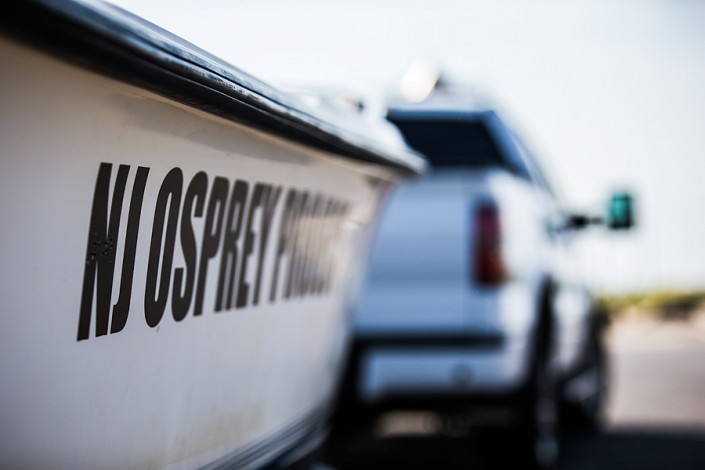
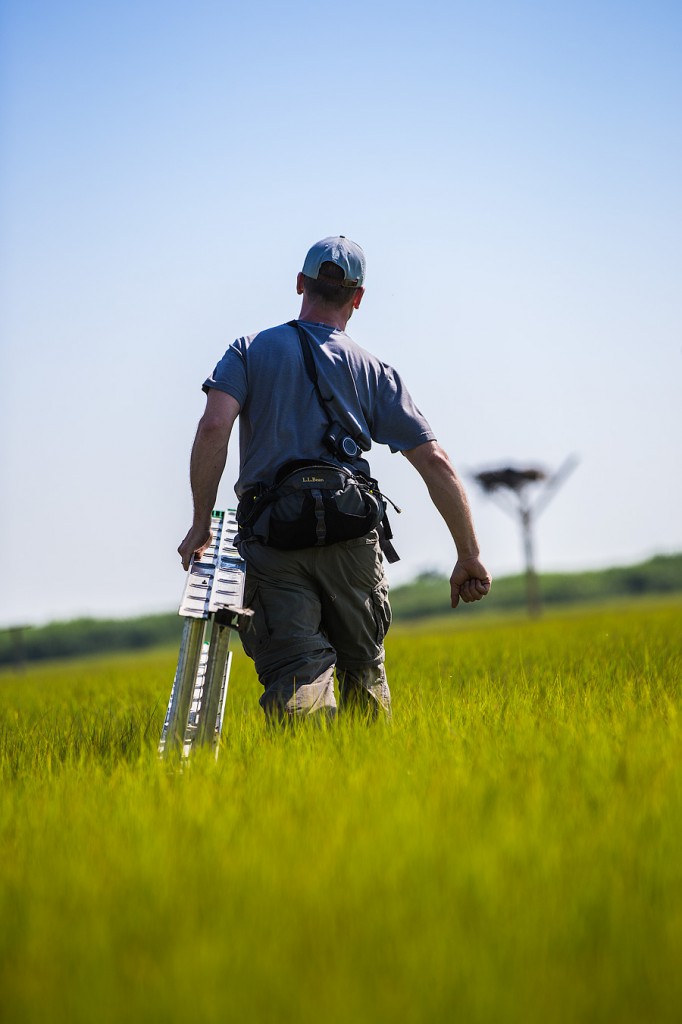
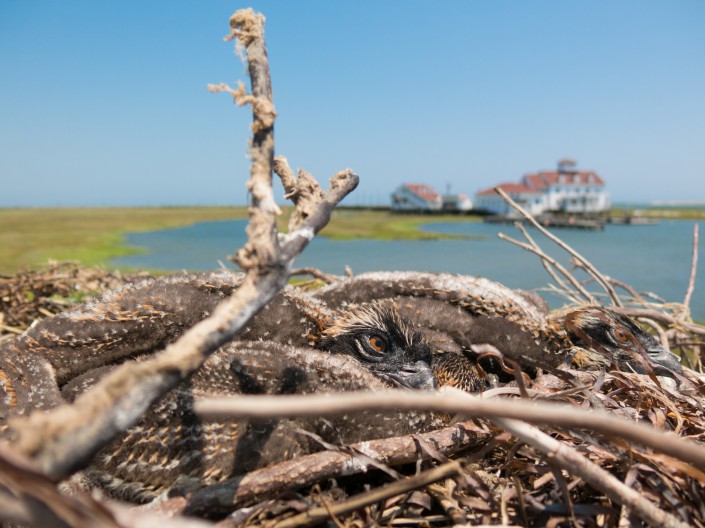
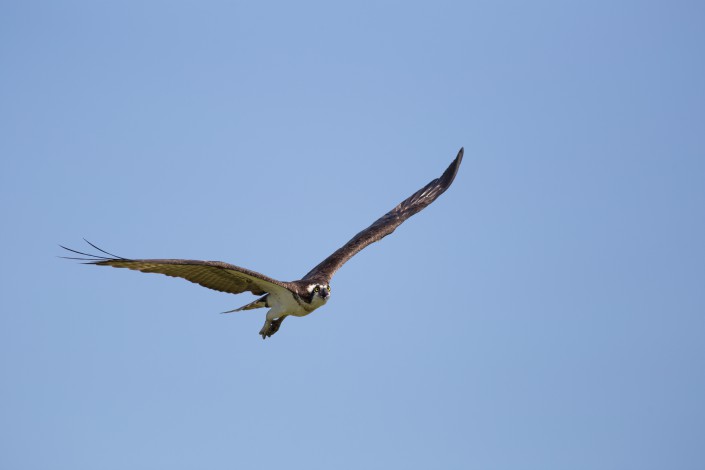
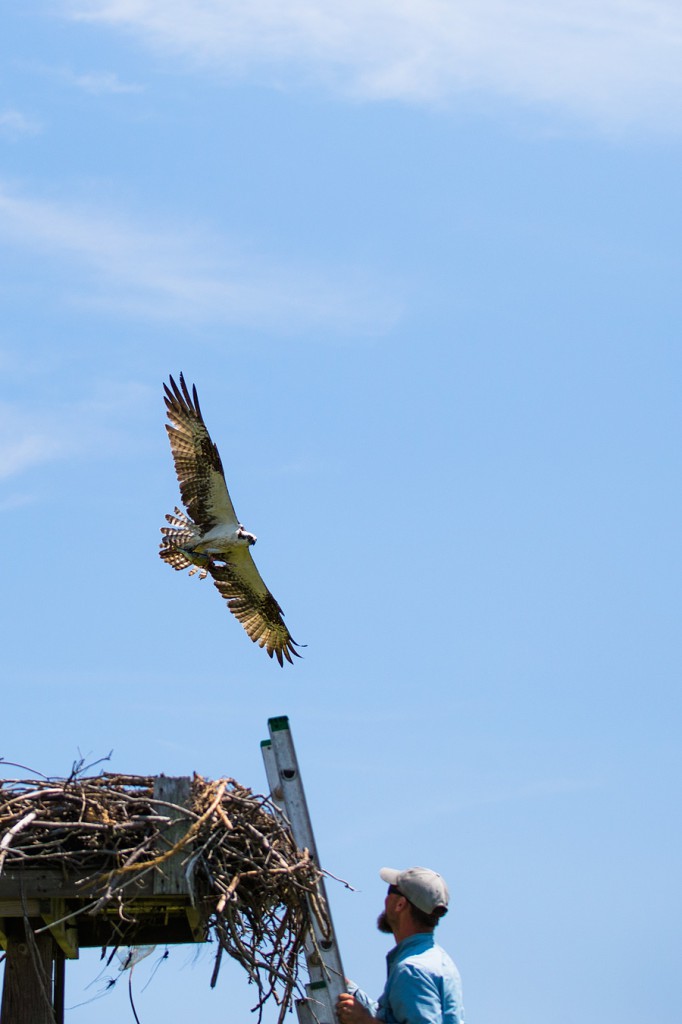
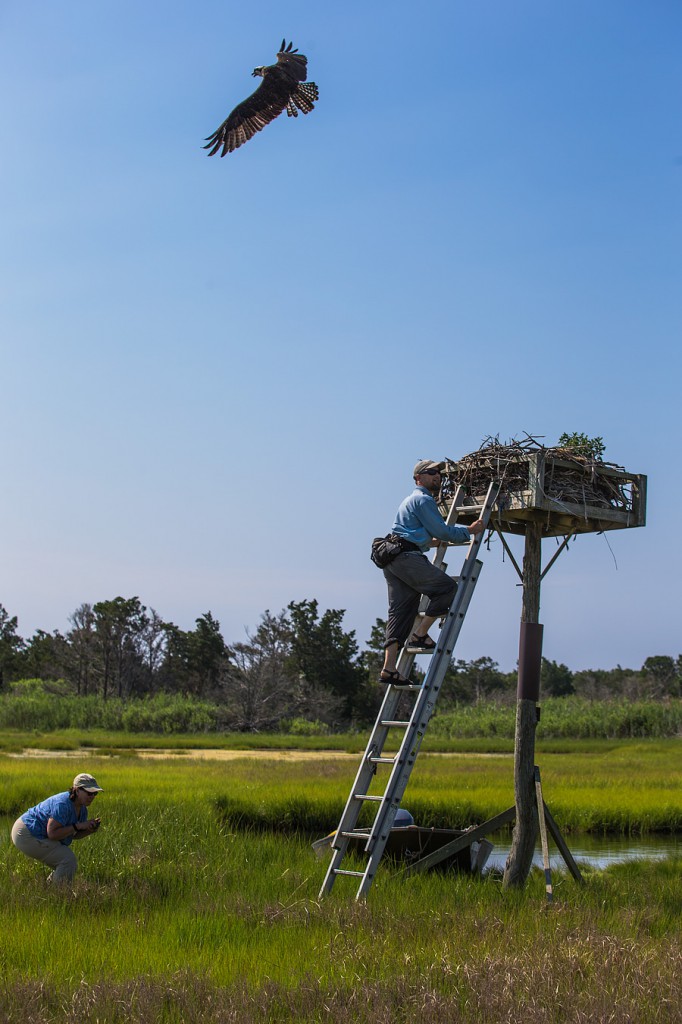
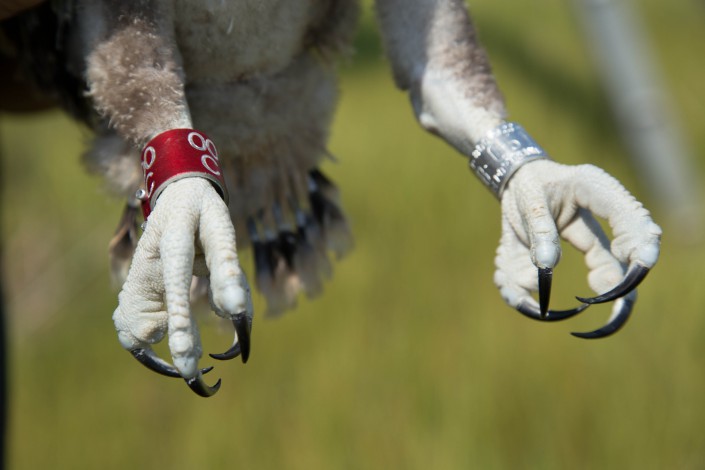
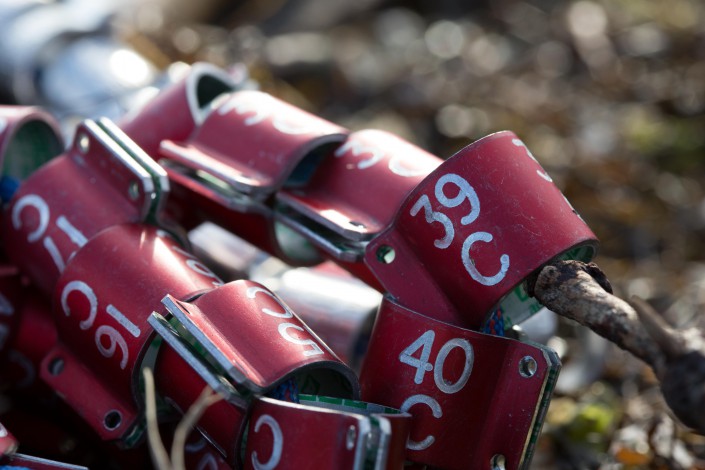
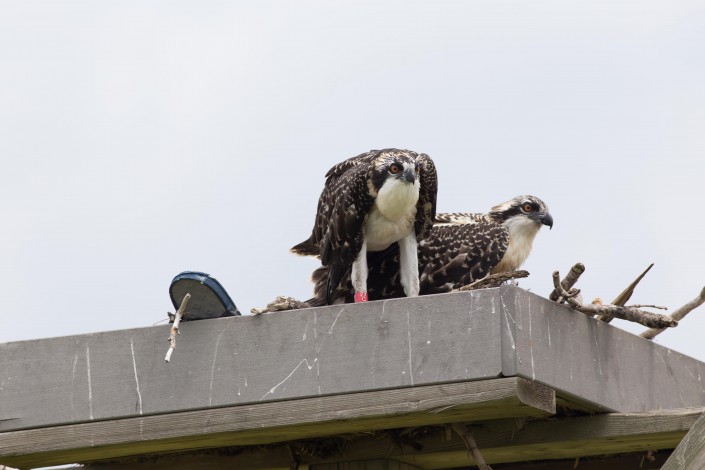
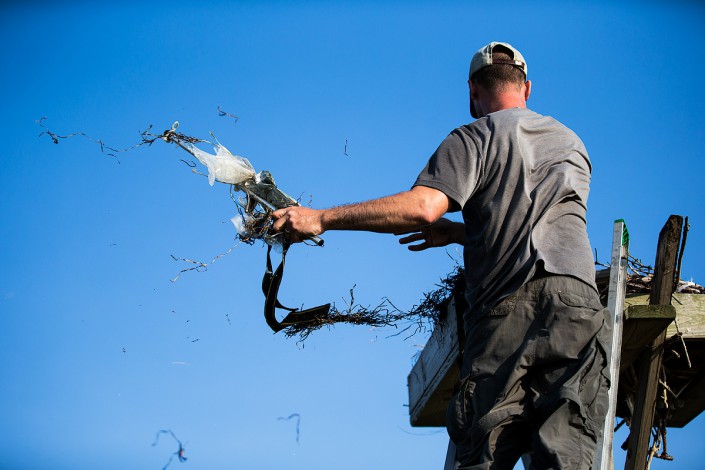
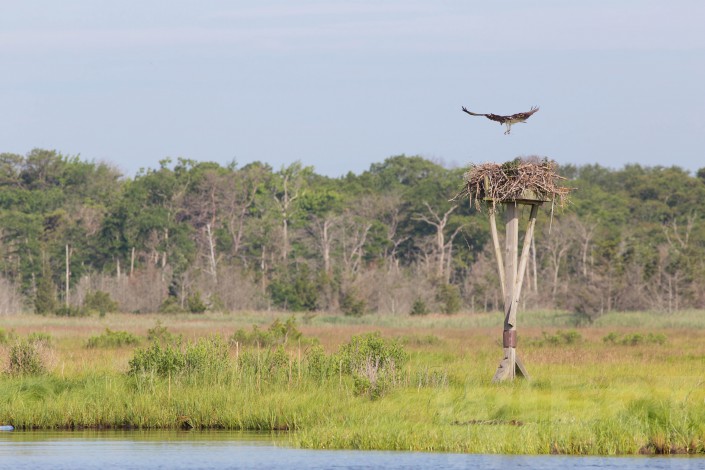
Terrapins and tires don’t mix!
Get college credit and help protect terrapins!
by Ben Wurst, Habitat Program Manager

Since 2010, Conserve Wildlife Foundation (CWF) has been engaged in the conservation of northern diamondback terrapins (Malaclemys terrapin terrapin) in the Little Egg Harbor area. This year, CWF seeks to continue to protect terrapins through additional conservation and education initiatives that include the installation and maintenance of barrier fencing, road patrols on Great Bay Blvd., and the continuation of this student internship. This year we are attempting to replicate a study conducted in 2004 on the same road, and results will help us to better determine how effective our conservation measures have been.
Interns will conduct field work in the lower Barnegat Bay watershed including hourly road patrols on Great Bay Blvd., volunteer steward scheduling and management, educational related activities, and the best part – save hundreds of female terrapins from becoming road kill!
Currently this is a volunteer student internship, but there is an opportunity for this to be a paid internship through the Barnegat Bay Student Grant Program. Willing students must develop a scientific research project to qualify for the grant. The deadline to apply is April 4th.
Interesting recaptures on Great Bay Blvd.
Barnegat Bay terrapin moves south…
by Ben Wurst, Habitat Program Manager
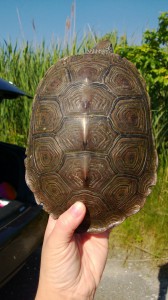
Northern diamondback terrapins are known to have a very small home range. Some have only been found to occupy the same small creeks, year after year. To help study the size of terrapin populations in New Jersey researchers have used a method called mark and recapture. No one really knows the size of the terrapins population in New Jersey and throughout the range of the Northern subspecies, which ranges from Cape Cod to Cape Hatteras. A portion of the population is captured, marked, and released. The method is repeated and the number of marked individuals is counted and should reflect a proportional number of marked individuals in the entire population.
Since 2001 terrapins have been marked on Great and Barnegat Bays. This past summer we got hits on three females that were PIT tagged (it’s like the Home Again chip for your pet). Their tags were read during road patrols by our intern Ashley. Two of the three were linked back to previous captures. Each is ID’d by the notches on their carapace (upper shell). Each bridge scute on their carapace is assigned a alpha code.
- ACIJV – First encountered on June 20, 2008 at age 7. Weighed 805 grams with a carapace length of 157cm. She was recaptured again this summer by Ashley on June 9. She is now 12 years old and weighed 934grams. Her carapace was 170cm long. She moved only .86 miles or 4,561 feet from her last encounter, which is typically the small range seen in terrapins.
- The second is ABINOQ – she was orginally trapped on Barnegat Bay (near Gunning River and the Barnegat Docks) on August 23, 2011. She was 8 when trapped and weighed 766 grams with a CL of 170mm. She was re-caught this summer while crossing Great Bay Blvd in Little Egg Harbor. This now makes her 10 years old and she weighed 965 grams and had a CL of 180mm. Now she moved a total of 16.7 miles in two years!!
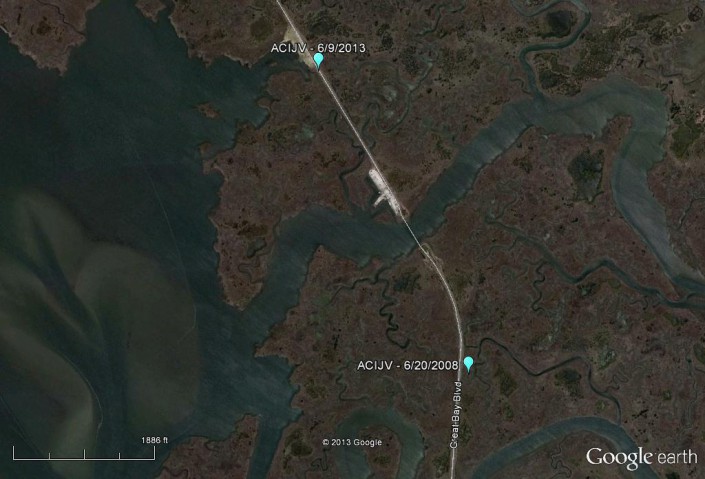
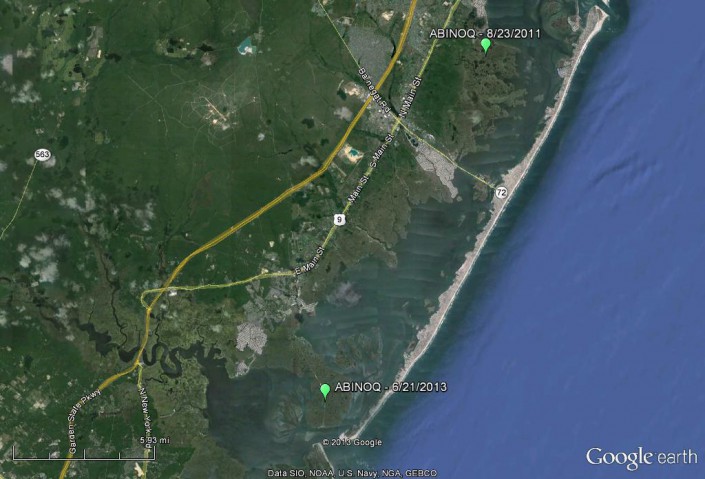
I find it really hard to believe that ABINOQ traveled 16 miles south in two years. There are a couple ways that she could have moved that far south. Superstorm Sandy – I think that this is a good possibility. Usually in late October most terrapins should have been entering hibernation, but a few could have still been active. I got a couple calls shortly after the storm hit from residents in the Little Egg Harbor area who found displaced terrapins in their yards. Given the fact that upwards of 6 feet of water were forced onto the coastal marshes with the storm surge, this could have pushed ABINOQ south towards Great Bay Blvd, where she was encountered this summer. Human intervention – this is also a very likely scenario. People often pick up terrapins when they find them on or near roads and sometimes take them home. Other times they take them and put them somewhere else, where they think they should belong… This summer I found a large female on an inland road in Upper Twp. (Cape May County). She was over 1.5 miles from any kind of brackish water…which is a long distance for any aquatic turtle to travel on land!
These findings are really interesting and with the data collected we’ll be able to learn a lot more about the local terrapin population. We hope to expand the use of PIT tags readers by fundraising to purchase additional readers. If you’d like to donate to help us purchase one, please shoot me an email.
2013 Osprey Census: So far, so good!
Early results are good; public needed to help determine size of population
by Ben Wurst, Habitat Program Manager
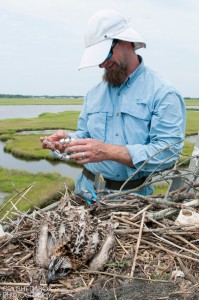
I just wrapped up the most intense field season in my entire career. In cooperation with NJ Fish & Wildlife’s Endangered and Nongame Species Program I help to monitor and manage the state population of ospreys. For the first time in four years we are conducting a statewide census for nesting ospreys. Almost all areas that I’ve surveyed, from Monmouth Beach to Atlantic City (and Wildwood) have done quite well, and the effects of Sandy on nesting ospreys appears to be minor.
Barnegat Bay is an area where I’ve concentrated much of my work. Over the past 5 years the number of available nesting platforms has tripled, from only a handful to over 50. Almost every platform was active this year. Amazing enough, this year on Barnegat Bay, a total of four nests produced four young each (one can be viewed on a live streaming camera at Island Beach State Park)!! This is quite a rare occurrence and is something I’ve never seen, especially for all of them to be on the same watershed is simply amazing!! Full results from all the surveys will be released in early fall. All of the data collected from surveys will be used in the census and we are looking for the public to help fill in valuable gaps in data.
Ospreys are indicators of a healthy marine environment. Ospreys are top tier predators who feed exclusively on fish. Many contaminants runoff into our coastal waters and over time become biomagnified through the food chain. Ospreys are extremely sensitive to many contaminants, including organochlorine pesticides (DDT), polychlorinated biphenyls (PCBs), and heavy metals. Since ospreys eat the same fish that we do, then their health also has implications for people. So, the bottom line is that it is important to monitor the nesting activity of ospreys in New Jersey!
We need your help:
For the first time in the project’s history we’re attempting a statewide census of nesting ospreys without the use of aerial surveys! This was a common (and very effective) way of surveying large areas in a short amount of time with only very minimal staff effort. Some things have changed since the 1970s and 80s….the survival of ospreys are not in jeopardy and helicopter surveys are much more expensive now! Over the past 6+ years, with help from many dedicated volunteers, we have surveyed around 70% of the known population in New Jersey. This year, CWF and NJ Fish & Wildlife’s Endangered and Nongame Species Program decided to release the locations of almost 1,000 known nest sites for ospreys to the Center for Conservation Biology’s Osprey Watch, a global osprey watching community website.
On Osprey Watch anyone can see nest sites and then report nesting activity at those nests. Users can join our monitoring group “New Jersey Osprey Project” and report on any nests they watch or where we are lacking data. You can also map new nests, add photos, and even indicate the type of nesting structure. It’s a pretty awesome website for anyone who is into ospreys!! 🙂
Herring Island Osprey Platform Install
Helping wildlife affected by Sandy
by Ben Wurst, Habitat Program Manager
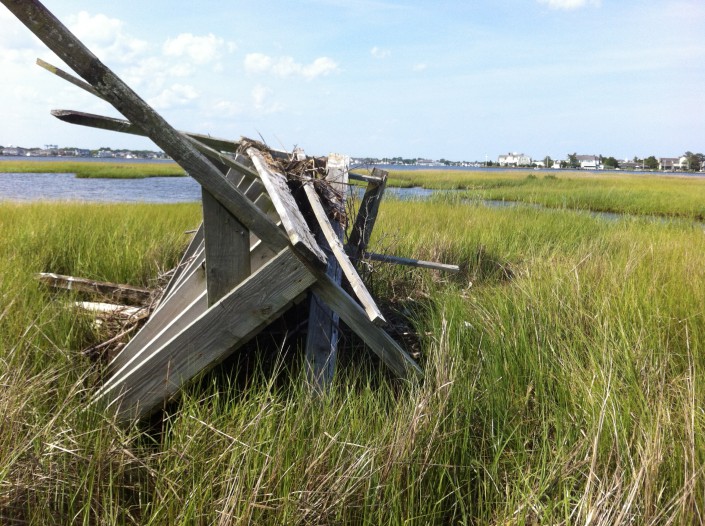
Since Sandy slammed into the coast of New Jersey we have been actively surveying damage to habitat that wildlife need to survive. Ospreys are currently on their wintering grounds in N. South America but their many nesting platforms were right in the middle of the high winds and strong storm surge from Sandy. For the most part, the majority of the platforms weathered the storm. Some of the old, small, and weak platforms were carried away with the surge (like this old duck blind on Herring Island on N. Barnegat Bay).
Ospreys mate for life and have a high level of site fidelity, so the nesting pair (if they survive the wintering season) will return to the same nest, and do so year after year. For the platforms that were occupied and washed away, we aren’t sitting around waiting for issues to arise when ospreys return to their nest sites next March. Since Sandy hit on October 29th we have already installed 5 new nesting platforms. Two platforms were installed on December 1st on Herring Island, which is right in the middle of the area where Sandy had devastating effects on the shoreline. The platforms were built before the storm by Point Pleasant resident Tom Vannostrand. The new platforms were installed to replace an old duck blind that was damaged late last year (possibly from Irene) and washed away by Sandy. When the pair of ospreys returned to nest on the blind this year they found that their nesting structure was damaged and attempted to build a nest on a nearby home. Long story short, the homeowners weren’t so happy and had the nest removed by USDA.
You can help us build and replace other platforms damaged by Sandy. On January 19th, from 10-3pm we are hosting a volunteer build day to construct 20 nesting platforms.
- Learn More
